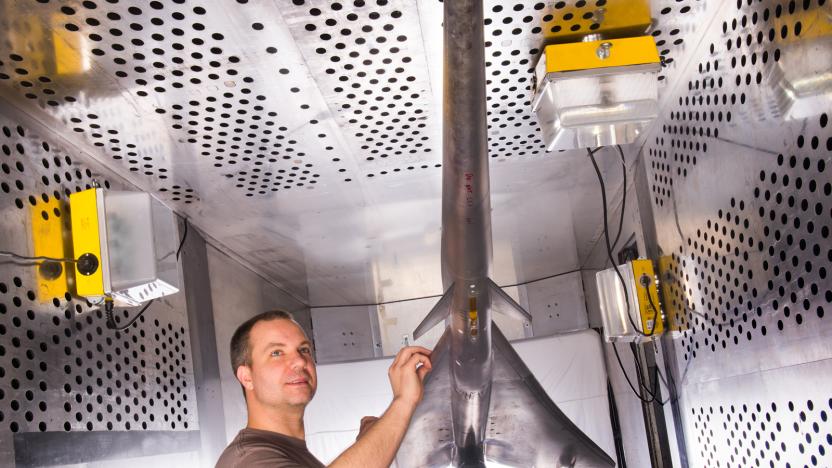WindTunnel
Latest

BMW is helping to build the world's fastest racing drone
BMW is working with the Drone Racing League (DRL) to break the record for the world's fastest drone set by the DRL itself last year. BMW will loan its technical expertise and wind tunnel at its Aerodynamic Test Center to help the league break the 165.2 mph Guinness world speed record it set with its DRL RacerX drone. The automaker is also bring a DRL race to its BMW Welt exhibition center and museum in Munich, Germany.

NASA starts wind tunnel tests for its quiet supersonic jet
NASA's plans for a quiet supersonic jet, the QueSST, just became tangible: the agency and Lockheed Martin have started wind tunnel tests for the future X-plane. It's a scale model at this stage, but it will be subjected to winds as high as Mach 1.6 (950MPH) to gauge both its aerodynamic performance as well as parts of its propulsion system. The tests should run until the middle of 2017.

NASA uses pressure-sensitive paint to test its rockets
How can NASA make sure its rockets are ready to handle the intense buffeting produced during launch? Scientists have recently started using pressure-sensitive paint (PSP) that reacts with oxygen to produce light. That way, scientists can actually visualize where the changing forces act on the rocket as it simulates acceleration during testing. The traditional method uses tiny microphones to measure buffeting, while this "unsteady" PSP is sprayed on in a thin layer, and contains pores so air can contact a greater surface area of the paint. Among other applications, it can be used to speed up and lower the cost of testing on projects like the Space Launch System.

Stanford wind tunnel for birds could lead to more stable drones
Birds can navigate both urban and real jungles with ease even when they're facing moderately turbulent winds. If they could speak, we'd have already asked their secret. But since they can't, the Stanford School of Engineering built one of the most advanced wind tunnels in the world. It's where assistant professor David Lentink study them more closely in order to develop more stable drones. The tunnel has a turbulence generator that simulates different wind speeds and patterns, as well as high-speed cameras that record every flap of the birds' wings as they fly inside.

Visualized: Boeing supersonic airliner concept soars in a wind tunnel, quietly
No, you're not looking at an early preview of Star Wars Episode VII -- it just might represent the future of air transport, though. Boeing has spent years developing a truly quiet supersonic airliner concept, the Icon II, and what you see is an aerodynamics test of a mockup in a vaguely Death Star-like wind tunnel at NASA's Glenn Research Center. The starfighter design is for more than just show, as you'd suspect. Its V-tail design moves sonic booms further back, reducing the chance that shockwaves will reach the ground (and our ears) intact, while the top-mounted engines isolate engine noise. Boeing and NASA are ultimately hoping for production passenger aircraft discreet enough to fly over land at supersonic speeds, although we can't help but think that the sci-fi look is a convenient bonus.

Wind tunnel PC case pushes the air cooling envelope, does its thing for cancer research
Pushing air cooling to its limits might mean buying a bigger fan to the mortal PC builder, but for Mike at Total Geekdom, it meant constructing a wind tunnel case. Built from a box fan, medium-density fiberboard, lexan and aluminum, the tunnel increases airspeed by about 240 percent and cools its contents with a brisk 9 mph breeze. At full bore, however, the fan churns out air speeds between 26 and 30 mph inside the case's sweet spot. As for computer hardware, the rig packs an Ivy Bridge 3770K processor, a pair of Radeon 7970 (Sapphire Dual-X) GPUs, 8GB of RAM and a 40GB SSD. There's still room to overclock the beast, but it currently keeps its CPU humming at 4.5GHz with temperatures between 64 and 65 degrees Celsius, and can run its GPUs at 1225MHz with core temperatures at 46 and 56 degrees Celsius. So, what does one do with a wind tunnel-cooled PC? Why donate time and computing processes for cancer research through the World Community Grid project, of course. For photos, performance specs and a full break down of the construction process, hit the bordering source link.

Visualized: futuristic AMELIA aircraft (theoretically) soars through NASA wind tunnel
It's the Advanced Model for Extreme Lift and Improved Aeroacoustics, and it's the brainchild of many, many intelligent beings planted at California Polytechnic State University. The aircraft has been in design courtesy of a grant from NASA, touting engines above the wings and the ability to achieve shockingly short takeoffs and landings. And did we mention it looks sexier than a freshly-washed 787? Yeah.





